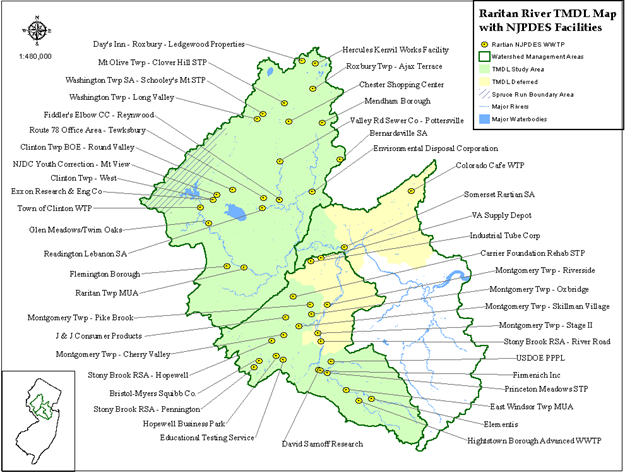Permitted polluting of New Jersey’s waters
We know that waters throughout the Raritan Basin contain unsafe levels of nutrients, fecal coliform and other pollutants – much of this type of polluting is directly related to “non-point source” pollution, most often stormwater runoff, which can be linked to land development and an excess of hard or “impervious” surfaces like roadways, asphalt parking lots, and buildings. Portions of our Lower Raritan Watershed also fail to meet federal Clean Water Act standards for phosphorous, pH, arsenic, chromium, mercury, copper, lead, temperature, dissolved oxygen, total dissolved solids and other pollutants. Some of this is due to historic “point source” dumping and legacy contaminants, and some of this is due to ongoing permitted point source polluting.
What is Permitted Point Source Polluting and who are New Jersey’s Permitted Polluters?
The New Jersey Pollution Discharge Elimination System (NJPDES) Program is designed to protect New Jersey’s ground and surface water quality by regulating treatment and discharge of polluted wastewater and stormwater from various types of facilities and activities. To accomplish this, the New Jersey Department of Environmental Protection (NJDEP) issues permits to polluting facilities limiting the mass and/or concentration of pollutants which may be discharged into ground water, streams, rivers, and the ocean. The types of regulated facilities can range from small users to large industrial and municipal wastewater dischargers. A complete list of the NJPDES permitted polluters for 2020 can be found here:
How can we protect our waterways from point source pollution?
The NJDEP is required by the Clean Water Act to create and implement a plan to remove pollution from impaired water bodies. They do this by preparing a TMDL, or Total Maximum Daily Load determination for a water body. A TMDL is a scientific determination of the maximum amount of a given pollutant that a surface water body can absorb and still protect human health and aquatic life.
Unfortunately for the Lower Raritan, we do not have a TMDL. A TMDL to address pollution in the Raritan Basin was begun in 2016, but for our area – the Lower Raritan Watershed – it is incomplete. The white area in the map below shows swaths of land, and the NJPDES Facilities (permitted polluters) on that land that are not covered by a TMDL. Now this does not mean that polluters can pollute at will, but what it does mean is that we have less of a real sense for what pollutants are in our waters, or for what harm the mix of pollutants might cause.

